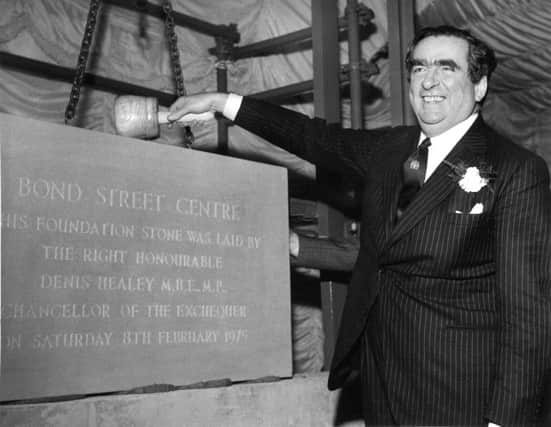Nostalgia on Tuesday: The name's Bond


The first part of the cross-town route was created in 1806 when Commercial Street (originally titled Bond Street) was laid out, extending from the west side of Briggate. Soon afterwards, the route westwards was augmented with the opening of Bond Street, running across Park Row to link with Infirmary Street and West Street. This new route was part of a plan to improve the town. Amongst the other projects carried out were the clearing of Briggate, improving the north south flow, and the opening of Wellington Road providing better access to the town from the west.
Bond Street was occupied by many varied commercial and business premises including property owned by the Leeds Savings Bank and a feather business run by John Whitehead and Co. In June 1824, Whitehead announced, ‘at all times he would have the very best goose feathers from Lincolnshire’.
Advertisement
Hide AdAdvertisement
Hide AdDuring the early 20th century The Yorkshire Post, occupying the Bond Street/Albion Street corner, reported the Fashion House of Marshalls, in Bond Street, was ‘setting the seal of distinction on the trading position of Leeds’. On December 12 1922, the newspaper reported the store’s afternoon mannequin parades were an alluring feature, adding: ‘Though generally regarded as an ultra-refinement of luxury shopping, the mannequin parade is essentially a practical institution, appealing to the practical sense which women combine with admiration of dainty finery...The attraction of the Fashion House windows is so well known; they form a brilliant kaleidoscope of the departmental wealth within’.
In March 1928 Leeds became the first town in England to install automatic traffic lights at the Park Row/Bond Street corner. Around the same time east west traffic along Commercial Street and Bond Street was given some relief with the establishment of the Headrow along the old Guildford Street, Upperheadrow and Lowerheadrow. Dilapidated property was demolished on the north side of these thoroughfares to form a new 80 ft wide street. Noted traders on Bond Street included Powolnys’ restaurant; J. Moffat, Milliner and Costumier; and Madame Louise.
After the Second World War, the way we shopped for food, clothing and many other items changed forever. This was brought about by the birth of the shopping mall. Richard A. Feinberg and Jennifer Meoli in A Brief History of the Mall (1991) inform: “The mall was originally conceived of as a community centre where people would converge for shopping, cultural activity, and social interaction. It is safe to say that the mall has achieved and surpassed those early expectations.”
Leeds’ first shopping mall, the largest commercial development in the city, was the Merrion Centre, opening on May 26, 1964. Bond street’s character was to alter considerably when a start was made on the £26m. Bond Street Shopping Centre, surrounded by the streets of Bond Street, Albion Street, Boar Lane and Lower Basinghall Street.
Advertisement
Hide AdAdvertisement
Hide AdA foundation stone laid on Saturday February 8, 1975 by Rt Hon Denis Healey MP. At the ceremony, Healey predicted Leeds would become a place of pilgrimage for planners from all over Europe. It would become a model to the country as the town hall, built 100 years earlier, had been, said Healey. He was sure that the quality of design of the complex had greatly benefited from the discussions the developers, Raglan Property Trust had enjoyed with Leeds Corporation and would fit in with the rest of the local architecture.
During January 1977 it was predicted that the opening of the palatial marble-halled Bond Street Shopping Centre during the second half of March 1977 would put Leeds alongside the leading shopping centres in the world. The Centre’s overall manager. Brian Battersby said: “We anticipate 20,000 people in this centre at any one time. Fire precautions have been geared to get them all out in 11 minutes.”
The dynamic driving force behind the birth of the Bond Street development was 36-year-old Yorkshireman, David Anderson, managing director of the developers, Raglan. A Leeds firm John Brunton & Partners were appointed architects for the project. From the initial decision to proceed, the architects co-ordinated the total scheme from demolition through to commissioning in just 36 months - six months ahead of schedule. This was achieved by the establishment of first class working relationships with the structural engineers, White, Young and Partners; quantity surveyors, Rex Procter and Partners; main contractors, Sir Robert McAlpine and Sons Ltd; and service engineers Haden Young Ltd.
The centre was to be the final stage of the city’s redeveloped principal shopping area, known as the ‘Golden Square’. It was fully air conditioned and protected from the weather. As far as aesthetics were concerned no expense was spared – right down to the £30,000 spent on plants. Floor space in the edifice did not come cheap – £22,000 to £25,000 a year for the smaller units, up to well over £300,000 for the larger stores.
Advertisement
Hide AdAdvertisement
Hide AdIn time the Bond Street Shopping Centre changed its name to the Leeds Shopping Plaza before being absorbed into the Trinity Leeds, which opened on March 21, 2013.
Thanks to Leeds Library for help with this piece.